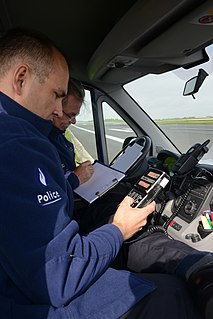
Civil defense or civil protection is an effort to protect the citizens of a state from man-made and natural disasters. It uses the principles of emergency operations: prevention, mitigation, preparation, response, or emergency evacuation and recovery. Programs of this sort were initially discussed at least as early as the 1920s and were implemented in some countries during the 1930s as the threat of war and aerial bombardment grew. Civil-defense structures became widespread after authorities recognised the threats posed by nuclear weapons.

The Federal Emergency Management Agency (FEMA) is an agency of the United States Department of Homeland Security (DHS), initially created under President Jimmy Carter by Presidential Reorganization Plan No. 3 of 1978 and implemented by two Executive Orders on April 1, 1979. The agency's primary purpose is to coordinate the response to a disaster that has occurred in the United States and that overwhelms the resources of local and state authorities. The governor of the state in which the disaster occurs must declare a state of emergency and formally request from the President that FEMA and the federal government respond to the disaster. The only exception to the state's gubernatorial declaration requirement occurs when an emergency or disaster takes place on federal property or to a federal asset—for example, the 1995 bombing of the Alfred P. Murrah Federal Building in Oklahoma City, Oklahoma, or the Space Shuttle Columbia in the 2003 return-flight disaster.

The Bundesanstalt Technisches Hilfswerk is the federal civil protection organisation of Germany. It is controlled by the German federal government. 99% of its 79,543 members (2019) are volunteers.

Emergency management, also called emergency response or disaster management, is the organization and management of the resources and responsibilities for dealing with all humanitarian aspects of emergencies. The aim is to prevent and reduce the harmful effects of all hazards, including disasters.

The Directorate of special units (DSU) is the police tactical unit of the Belgian Federal Police. In total, DSU consists of about 500 highly trained police officers. The centralized 50 operator small assault team of the intervention unit of the DSU is deployed in cases of terrorism, kidnappings, hostage taking and other forms of serious crime. DSU performs emergency responses, high-risk arrests and searches, observation operations, undercover operations and more.

The Danish Emergency Management Agency (DEMA) is a Danish governmental agency under the Ministry of Defence. Its principal task is to manage an operational part who work out of six Emergency Management Centres, and administrative and legalizing part, who supervises the national and municipal rescue preparedness and advises the authorities on matters of preparedness. DEMA works in closely structured co-operation with the EU, UN and several neighbouring countries.
As firefighting has a rich history throughout the world, traditions in this profession vary widely from country to country.

Law enforcement in Belgium is conducted by an integrated police service structured on the federal and local levels, made up of the Federal Police and the Local Police. Both forces are autonomous and subordinate to different authorities, but linked in regard to reciprocal support, recruitment, manpower mobility and common training.
The counter-terrorism page primarily deals with special police or military organizations that carry out arrest or direct combat with terrorists. This page deals with the other aspects of counter-terrorism:

In many countries, particularly those with a federal system of government, there may be several law enforcement agencies, police or police-like organizations, each serving different levels of government and enforcing different subsets of the applicable law.

The Belgian Federal Police, is the national police force of the Kingdom of Belgium. It carries out specialized and supra-local administrative and judicial police operations, and supports local police services when needed. Additionally, the Federal Police is responsible for patrolling and ensuring the safety of the country’s highways. The Federal Police has approximately 12,300 officers and civilian personnel.

The Gendarmery is the national gendarmerie force of the Republic of Serbia. It is under the authority of the Police Directorate of the Serbian Ministry of Interior and was formed on 28 June 2001, after the disbandment of the Special Police Units (PJP). Gendarmery in Serbia existed in previous form from 1860 to 1920. As a special unit inside Serbian police, its role can be compared to those of Russian OMON and former Ukrainian Berkut units.
The California Governor's Office of Emergency Services is a California cabinet-level office responsible for overseeing and coordinating emergency preparedness, response, recovery and homeland security activities within the state. The agency was created by AB 38 (2008), superseding both the Office of Emergency Services (OES) and Office of Homeland Security (OHS).

The Vigili del Fuoco is Italy's institutional agency for fire and rescue service. It is part of the Ministry of Interior's Dipartimento dei Vigili del Fuoco, del Soccorso Pubblico e della Difesa Civile. The Corps' task is to provide safety for people, animals, and property, and to give technical assistance to industries, as well as providing fire prevention advice. It also ensures public safety in terrorist emergencies such as chemical, bacteriological, radiological, and nuclear attacks.

The Ministry of Interior of the Republic of Bulgaria is the ministry charged with the national security and the upholding of law and order in the country.
Many countries around the world have civil defense organizations dedicated to protecting civilians from military attacks and providing rescue services after widespread disasters. In most countries, civil defense is a government-managed and often volunteer-staffed organization.

The Ministry of Emergency Situations of Belarus is a government agency overseeing emergency services in Belarus. It is responsible for protecting the Belarusian people during natural disasters. It is located on Revaliucyjnaja Street in Minsk. The Ministry for Emergency Situations was established in accordance a decree of President Alexander Lukashenko on September 23, 1994.

The Ministry of Emergency Situations of Armenia (MES) is a government agency overseeing the civil emergency services in Armenia. The ministry was formed by presidential decree on 21 April 2008.
The Directorate-General for Civil Protection and Emergencies (DGPCE) is a component of the Spanish Department of the Interior responsible for promoting, planning and coordinating the various actors involved in the field of civil defence, both national and international.




























